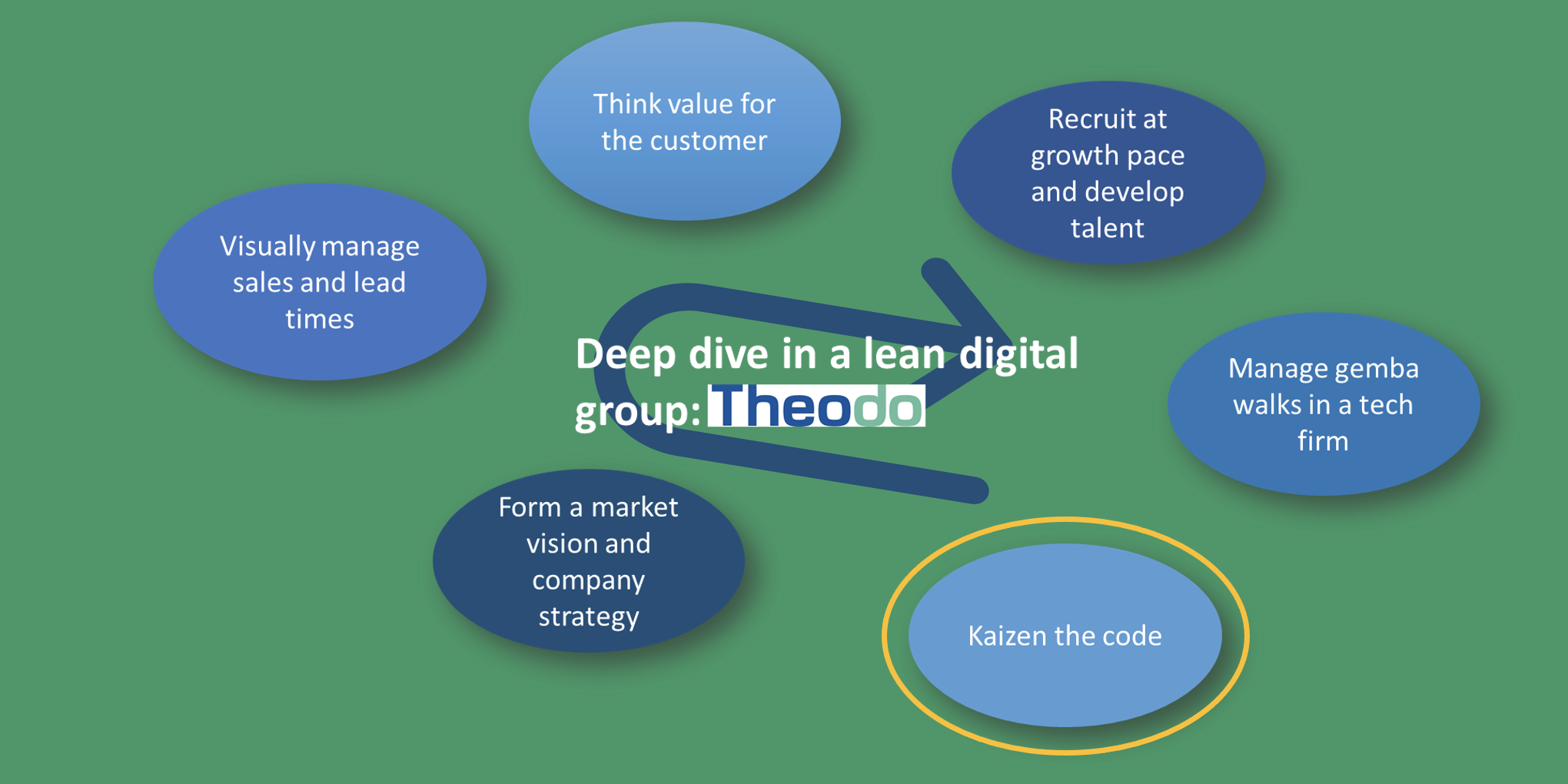
Avoid deterioration of results with solid daily management
INTERVIEW – Does your company feel like a sand castle? Do you struggle to sustain lean results? The CEO of Lantech tells us how the firm is using a daily management system to prevent “deterioration”.
Interviewee: Jim Lancaster, CEO, Lantech
Roberto Priolo: Why do so many organizations struggle to keep their lean results coming? And why, in your experience, does a solid daily management system help?
Jim Lancaster: One of the things I found over many years applying lean thinking is that achieving the improvements is in itself not that difficult. At Lantech, we could accomplish anything we set out to do, as long as we could focus the attention of everyone in the organization on that one goal.
The problem came when it became apparent that whatever improvement we could achieve was being offset by some “deterioration” taking place somewhere else in the organization. Our material cost savings projects are perhaps the best example: we were saving $400,000 to $500,000 annually from these projects. But at the end of the year our materials in total would cost the same amount they had cost the year before! It was so frustrating.
Deterioration was the silent enemy preventing improvements from benefiting our income statement. I understood that as a concept, but only when I started to spend time on the floor and saw the deterioration happen in front of me did I understand how big a problem it actually was.
When we introduce standardized work, before we leave the area we must put a process in place that makes the standards and their application visible – so that we can manage them and maintain the results we achieve. If we don’t, we won’t get a long-term return, and our efforts will never turn into competitive advantage, which is the whole reason why we embrace lean in the first place.
RP: What are the warning signs that a daily management system is not working?
JL: A lot of organizations introduce some kind of daily walk around early in the process, but most times (and we tried this ourselves) these are nothing more than moving staff meetings that don't really change the internal dynamics because they do not precisely correct the front level work cross functionally and vertically in the organization so support can be provided instantly. That visibility then must be reacted to with certainty in a standard way by a management system capable of dealing with the variances and problems that come up.
The daily management process I talk about in my book The Work of Management is not about a staff meeting, (A staff meeting is about updating the boss so she/he can do whatever she/he does) but about trying to combat deterioration through fast response support. A key trigger to send support is a metric moving off of standard. In our case, we track safety, quality, delivery, cost and skills every single day, and this tells us whether or not we are ready for the work ahead. If we identify a problem quickly (and measuring every day means we normally do), fixing it won’t be difficult, so long as the management reaction there on the spot is to go see. If this is not happening, then you know you don’t have a working daily management system. You can’t solve problems from a distance.
RP: How does having a strong daily management system in place support kaizen on one side and hoshin planning on the other?

JL: Let me take the two separately. In terms of kaizen-type events, every time we make an improvement we must be “mindful of the retreat,” as we say at Lantech. This means leaving the area we just improved with a method that makes deterioration visible, so that (as I was saying a moment ago) we can react using the Daily Management System.
With regards to hoshin planning, let me say that all functional leaders in a business should get a weekly, nearly daily fully cross-functional dip in the organization. The top level daily walk allows this to happen. This way nothing comes as a surprise when strategic planning takes place: people know that, for example, engineers have been struggling with a software program, or that a production line has a quality problem. As a result, providing them with the cross functional support they need will be easier.
Having a clear idea of what’s going on in the business means that, as an executive, I know what the top 50-60 people are doing on a daily basis and how well the actual value add work is being performed across the company. This helps me to pick strategies that we can all pursue together that tie to today’s Capabilities and Opportunities.
Lastly, when we lay out our strategic plans and they roll out in an A3 format, we can break them down into monthly, weekly and daily chunks of work – each with its own deliverables – that we put in the 2 week deliverable calendars in each functional area. We walk right by those as we head to the daily boards and if there is a problem, we are sure to notice the red Andon card and stop to hear about it. This is critical: we try to help our people problem solve so they have a better chance of meeting the deliverable, rather than sit back at the end of the month and complain or blame them when they have missed their target. After all, it is our job in management to support people in doing their job.
RP: How did the transition from modern to lean management feel to you personally as you took over as CEO?
JL: I was 28 when I took over the company and, in case you are wondering, I thought I knew everything at that point. My dad had been there before me and I knew all the things that, in my eyes, needed fixing, and I was ready to hit the ground running. Indeed, in the first couple of years I made tremendous progress simply by changing the stuff that I knew wasn’t working.
Pretty soon, however, the deterioration problem arose. And that’s when things got difficult, and the transition became necessary. After a few years chasing big goals and making big plans, I was seeing the results of large initiatives being offset by deterioration elsewhere. That’s when I realized I had to do things differently. Here’s an example: we recently insourced the vast majority of our fabrications – a large endeavor, entailing a new building, machinery, a lot of new process and part delivery challenges. Thanks to daily management we managed to implement in just six months.
RP: What are the biggest takeaways from your new book The Work of Management?
JL: First of all, that readers intimately understand this deterioration concept (and believe that their business processes will be like a sand castle washing away quickly without a proper system supporting those processes and people.) Secondly, that an organization needs a critical mass of leaders who have actually tried to maintain standards in order to sustain results. Leaders must understand that operators have a hard job to do in the face of thousands of variables – once they see that, their whole attitude towards solving problems will change. That’s what happened at Lantech at least, and this transition to management as support is the main thing I hope people get from reading the book.
In itself, the structure of the daily management system is not difficult to grasp – it looked complicated to execute at first, but we implemented the structure in a week and a half. What I want people to understand is that if they put the right system in place but don’t have the right behaviors and beliefs when they are standing by the boards, they won’t get anywhere.
RP: What made daily management successful at Lantech?
JL: The fact that we needed it! If we had put the system in place before understanding deterioration, we would have failed. The reason it worked is that top and middle management saw the problem – they too were frustrated with deterioration – and decided to go for a different approach to combat the problem.
RP: So, what is the “work of management” then?
JL: Management’s job is to maintain the current condition, making sure that we can do today as well what we did yesterday, and then and only then, the job is to improve the current condition. There is no point in improving if we can’t sustain.
A daily management system helps us to standardize everybody’s work – meaning we all do the same thing in the reaction to a certain occurrence – and put it in a sequence – when we go here, we do this; when we go there, we do that. This of course varies at different levels of management, all the way up to me. I, for one, have to ensure the standard work for the other levels of management can be maintained.
Have you purchased your copy of Jim's book?
Click here to buy one

THE INTERVIEWEE

Jim Lancaster is the CEO and owner of Lantech.com, headquartered in Louisville, KY. Known as the leader in stretch wrap innovation, Lantech sells its packaging and material-handling machinery worldwide to large consumer goods companies. The firm pioneered the use of lean principles in the early 1990s and its story is featured in Jim Womack and Dan Jones' Lean Thinking: Banish Waste and Create Wealth in Your Organization. Jim joined Lantech in 1990 and is now the lead executive driving its lean transformation.
Read more


FEATURE – For a few years now, Theodo has made of quality and customer satisfaction the main focus of its work, and it is paying off. But what does it mean to pursue and improve quality at a digital company?


FEATURE – The conflict unfolding in Ukraine acts as a tragic reminder of the threat posed by despotic, unapproachable, and paranoid leaders, says Sharon Visser.


FEATURE – As inflation bites, the author offers us an insightful take into what it really means to understand a company’s costs. Hint, it doesn’t involve passing them on to customers.


FEATURE – In this in-depth, insightful analysis, the authors explore the essence of bureaucracy and explain why, with Lean Thinking, it can be leveraged as a force for good.

